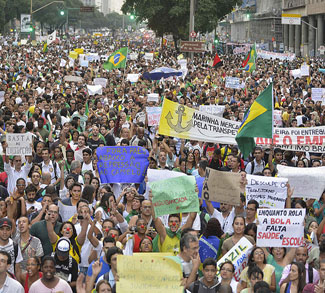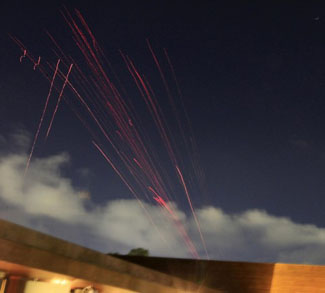Much of the global media has focused on the protests occurring throughout Brazil during this past week. Almost all have drawn their own conclusions as to the cause of the tumult, and almost all in splendid contradiction. Similarly, there has been an enduring preoccupation in most news reports with the violence and looting associated with all such public demonstrations.
In reality, both the causes and the effects of the Brazilian protests are only poorly understood at this point; and for its part, the violence portrayed in the media has primarily been the exception rather than the rule. I know. I was there. I watched while protestors massed outside Brazil’s Congress on the evening of June 17th, but stopped politely to let the bus carrying our delegation pass to return to our hotel. And on June 18th, I spent close to two hours on one of Brazil’s Wall Streets, the Avenida Paulista, accompanying tens of thousands as they marched peacefully in support of their “cause.”
Ostensibly, and as has been widely reported, Brazil’s protests have been linked to increases in transit fares amounting to single digit percentages; in São Paulo, representing approximately $0.10 on an average $1.50 subway or bus fare. In response, transit authorities in several cities have already reversed these increases. The protestors, for their part, vow to continue their fight.
This comes as no surprise. The reality is that the fare increases per se represent a significant symptom, but hardly the cause of the malaise currently affecting a wide spectrum of the Brazilian population. Most of the demonstrators, perhaps not unexpectedly, are youths. They are also predominantly middle class, heralding from families that could more than easily absorb a single digit percentage increase in transit fares. From their perspective, however, and as the multitude of the placards they carry clearly illustrate, they view the now-constant and endemic increases in bus fares, other public services, and even basic foodstuffs in Brazil as counterpoint to the billions of reais the country has invested, and will invest in infrastructure for showcase events like the World Cup and the Olympics. Price increases, in this context, are effectively seen by some as a tax on the youth and particularly the poor to help pay for what are seen as lavish excesses—designed primarily to impress foreign visitors. These are also the same billions of reais, in the view of the protestors, that could be directed to existing and pressing needs in Brazil to effect health care reform and vastly improve education. While credible arguments can be made, and are made, to suggest that such infrastructure investments will ultimately serve Brazil well, and attract needed foreign investment, taken in context, the protests are certainly understandable.
In fact, there are strong parallels with the political demonstrations that occurred in the early 1980s, when the then-ruling Brazilian military first indicated its intention to move the country back toward civilian rule after nearly 20 years in power. Then, the Diretas Ja (direct elections now) movement, counted heavily on idealistic youths, who took to the streets in the tens of thousands as part of an effort to speed up Brazil’s democratic transition. And to a considerable extent, they succeeded, with the return to electoral democracy in 1986 and the formulation of a new constitution two years later.
As Brazilians currently observe the effect of people power across the Arab world and elsewhere, they themselves—and particularly their youth—now return to their roots in the protests across the country that show no signs of slowing in the near term. What remains to be seen is the response from powers at the national level—led by the Partido dos Trabalhadores (Workers’ Party) and other political forces on the left that themselves were forged in the popular protests against Brazil’s military dictatorship (1964-1986).
Ted Hewitt is a professor at the University of Western Ontario and a contributor to Geopoliticalmonitor.com.




